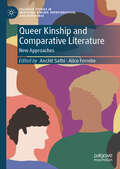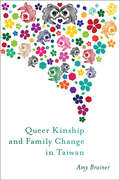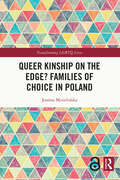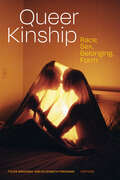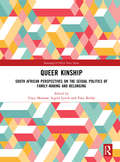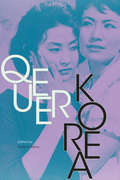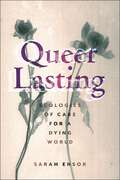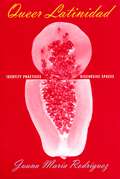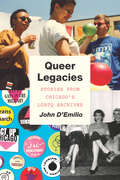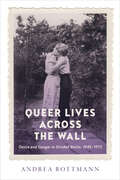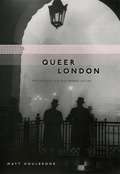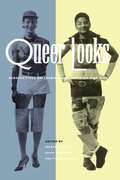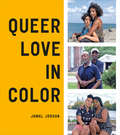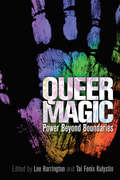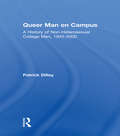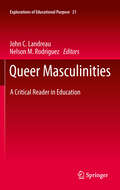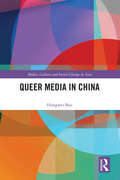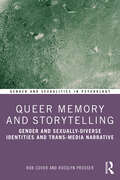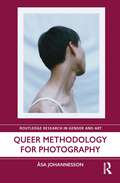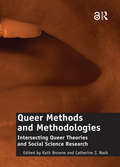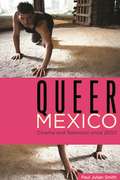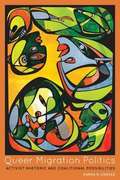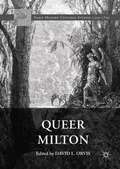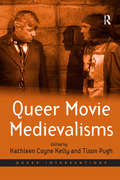- Table View
- List View
Queer Kinship and Comparative Literature: New Approaches (Palgrave Studies in Mediating Kinship, Representation, and Difference)
by Alice Ferrebe Anchit SathiThis edited collection provides a critical forum for scholars to examine the evolution of queer kinship—encompassing the wide range of relationships, both biological and nonbiological, that queer individuals choose (or are compelled) to establish—through its representation in literature over time and across cultural contexts. In particular, the ten essays in this collection utilize close readings, philosophy, and theory to address the following question: How can we conceptualize the nature of queer kinship based on its textual representations? To this end, the essays engage with a diverse array of texts, from Buddhist writing to contemporary song lyrics, French literature from the 17th and 18th centuries to contemporary drama and novels from Sweden, Israel, and the Anglosphere. This broad temporal and geographic scope yields new critical insights into the varied ontologies of queer kinship and highlights the inherent paradoxes and fundamental messiness in queer kinship formations across different times, spaces, and contexts. In doing so, the collection makes a significant and timely contribution to the fields of kinship studies, queer studies, and comparative literature.
Queer Kinship and Family Change in Taiwan (Families in Focus)
by Amy BrainerInterweaving the narratives of multiple family members, including parents and siblings of her queer and trans informants, Amy Brainer analyzes the strategies that families use to navigate their internal differences. In Queer Kinship and Family Change in Taiwan, Brainer looks across generational cohorts for clues about how larger social, cultural, and political shifts have materialized in people’s everyday lives. Her findings bring light to new parenting and family discourses and enduring inequalities that shape the experiences of queer and heterosexual kin alike. Brainer’s research takes her from political marches and support group meetings to family dinner tables in cities and small towns across Taiwan. She speaks with parents and siblings who vary in whether and to what extent they have made peace with having a queer or transgender family member, and queer and trans people who vary in what they hope for and expect from their families of origin. Across these diverse life stories, Brainer uses a feminist materialist framework to illuminate struggles for personal and sexual autonomy in the intimate context of family and home.
Queer Kinship on the Edge? Families of Choice in Poland (Transforming LGBTQ Lives)
by Joanna MizielińskaQueer Kinship on the Edge? Families of Choice in Poland explores ways in which queer families from Central and Eastern Europe complicate the mainstream picture of queer kinship and families researched in the Anglo-American contexts. The book presents findings from under-represented localities as a starting point to query some of the expectations about queer kinship and to provide insights on the scale and nature of queer kinship in diverse geopolitical locations and the complexities of lived experiences of queer families. Drawing on a rich qualitative multi-method study to address the gap in queer kinship studies which tend to exclude Polish or wider Central and Eastern perspectives, it offers a multi-dimensional picture of ‘families of choice’ improving sensitivity towards differences in queer kinship studies. Through case studies and interviews with diverse members of queer families (i.e., queer parents, their children) and their families of origin (parents and siblings), the book looks at queer domesticity, practices of care, defining and displaying families, queer parenthood familial homophobia, and interpersonal relationships through the life course. This study is suitable for those interested in LGBT studies, sexuality studies, kinship and Eastern European studies.
Queer Kinship: Race, Sex, Belonging, Form (Theory Q)
by Tyler BradwayThe contributors to this volume assert the importance of queer kinship to queer and trans theory and to kinship theory. In a contemporary moment marked by the rising tides of neoliberalism, fascism, xenophobia, and homo- and cis-nationalism, they approach kinship as both a horizon and a source of violence and possibility. The contributors challenge dominant theories of kinship that ignore the devastating impacts of chattel slavery, settler colonialism, and racialized nationalism on the bonds of Black and Indigenous people and people of color. Among other topics, they examine the “blood tie” as the legal marker of kin relations, the everyday experiences and memories of trans mothers and daughters in Istanbul, the outsourcing of reproductive labor in postcolonial India, kinship as a model of governance beyond the liberal state, and the intergenerational effects of the adoption of Indigenous children as a technology of settler colonialism. Queer Kinship pushes the methodological and theoretical underpinnings of queer theory forward while opening up new paths for studying kinship.Contributors. Aqdas Aftab, Leah Claire Allen, Tyler Bradway, Juliana Demartini Brito, Judith Butler, Dilara Çalışkan, Christopher Chamberlin, Aobo Dong, Brigitte Fielder, Elizabeth Freeman, John S. Garrison, Nat Hurley, Joseph M. Pierce, Mark Rifkin, Poulomi Saha, Kath Weston
Queer Kinship: South African Perspectives on the Sexual politics of Family-making and Belonging (Routledge/UNISA Press Series)
by Vasu Reddy Racy Morison Ingrid LynchWhat makes kinship queer? This collection from leading and emerging thinkers in gender and sexualities interrogates the politics of belonging, shining a light on the outcasts, rebels, and pioneers. Queer Kinship brings together an array of thought-provoking perspectives on what it means to love and be loved, to ‘do family’ and to belong in the South African context. The collection includes a number of different topic areas, disciplinary approaches, and theoretical lenses on familial relations, reproduction, and citizenship. The text amplifies the voices of those who are bending, breaking, and remaking the rules of being and belonging. Photo-essays and artworks offer moving glimpses into the new life worlds being created in and among the ‘normal’ and the mundane. Taken as a whole, this text offers a critical and intersectional perspective that addresses some important gaps in the scholarship on kinship and families. Queer Kinship makes an innovative contribution to international studies in kinship, gender, and sexualities. It will be a valuable resource to scholars, students, and activists working in these areas.
Queer Korea (Perverse Modernities: A Series Edited by Jack Halberstam and Lisa Lowe)
by Todd A. HenrySince the end of the nineteenth century, the Korean people have faced successive waves of foreign domination, authoritarian regimes, forced dispersal, and divided development. Throughout these turbulent times, “queer” Koreans were ignored, minimized, and erased in narratives of their modern nation, East Asia, and the wider world. This interdisciplinary volume challenges such marginalization through critical analyses of non-normative sexuality and gender variance. Considering both personal and collective forces, contributors extend individualized notions of queer neoliberalism beyond those typically set in Western queer theory. Along the way, they recount a range of illuminating topics, from shamanic rituals during the colonial era and B-grade comedy films under Cold War dictatorship to toxic masculinity in today’s South Korean military and transgender confrontations with the resident registration system. More broadly, Queer Korea offers readers new ways of understanding the limits and possibilities of human liberation under exclusionary conditions of modernity in Asia and beyond.Contributors. Pei Jean Chen, John (Song Pae) Cho, Chung-kang Kim, Timothy Gitzen, Todd A. Henry, Merose Hwang, Ruin, Layoung Shin, Shin-ae Ha, John Whittier Treat
Queer Lasting: Ecologies of Care for a Dying World (Sexual Cultures)
by Sarah EnsorWhat queer modes of resilience and care can teach us about enduring environmental collapseWhat does it mean to live at the end of life, the end of a family line, the end of a species, or the end of the future itself? When faced with unfurling catastrophes, environmentalists often limit the conversation by focusing on the future. Activists work for the welfare of future generations, while scientists labor over projections of future outcomes. In Queer Lasting, Sarah Ensor asks what this emphasis on the future makes unthinkable. She looks to queer scenes of futurelessness to consider what ecocriticism can learn from queer theory, which imagines and inhabits the immanent ethical possibilities of a terminal present. While living “at the last” is often a terrifying prospect, queer culture reminds us that “to last” is itself also one way to go on. Defining queerness as a mode of collective life in which these paradigms of lasting—ending and persisting—are constitutively intertwined, Ensor turns to two periods of queer extinction for models of care, continuance, and collective action predicated on futurelessness: the 1890s, in which existing forms of erotic affiliation were extinguished through the binary of homo/heterosexuality, and the 1980s, in which the spread of the AIDS epidemic threatened the total loss of gay lives and of specific erotic ways of life. Through readings that trace unexpected formal resonances across the works of Sarah Orne Jewett, Willa Cather, Melvin Dixon, Essex Hemphill, Allen Barnett, and Samuel Delany, Queer Lasting maintains that queer writing, in its intimacy with death and loss, offers a rich archive for imagining new ways of thinking through environmental collapse. Whether confronting the epidemic contours of the AIDS crisis, theorizing the temporary encounters of cruising, or reckoning with the lives of non-reproductive subjects, this book about futurelessness is also a book about persistence. It demonstrates how, far from giving up in the face of the terminal paradigms that environmentalism fears, queer culture has instead predicated its living—and its lasting—upon them.
Queer Latinidad: Identity Practices, Discursive Spaces (Sexual Cultures #24)
by Juana María RodríguezAn examination into queer identity in relation to Latino/a AmericaAccording to the 2000 census, Latinos/as have become the largest ethnic minority group in the United States. Images of Latinos and Latinas in mainstream news and in popular culture suggest a Latin Explosion at center stage, yet the topic of queer identity in relation to Latino/a America remains under examined. Juana María Rodríguez attempts to rectify this dearth of scholarship in Queer Latinidad: Identity Practices, Discursive Spaces, by documenting the ways in which identities are transformed by encounters with language, the law, culture, and public policy. She identifies three key areas as the project’s case studies: activism, primarily HIV prevention; immigration law; and cyberspace. In each, Rodríguez theorizes the ways queer Latino/a identities are enabled or constrained, melding several theoretical and methodological approaches to argue that these sites are complex and dynamic social fields.As she moves the reader from one disciplinary location to the other, Rodríguez reveals the seams of her own academic engagement with queer latinidad. This deftly crafted work represents a dynamic and innovative approach to the study of identity formation and representation, making a vital contribution to a new reformulation of gender and sexuality studies.
Queer Legacies: Stories from Chicago's LGBTQ Archives
by John D'EmilioThe variety of LGBTQ life in Chicago is too abundant and too diverse to be contained in a single place. But since 1981, the Gerber/Hart Library and Archives has striven to do just that, amassing a wealth of records related to the city’s gay, lesbian, bisexual, transgender, and queer-identified people and organizations. In Queer Legacies, John D’Emilio—a pioneering scholar in the field—digs deep into Gerber/Hart’s collection to unearth a kaleidoscopic look at the communities built by generations of LGBTQ people. Excavated from one of the country’s most important, yet overlooked, LGBTQ archives, D’Emilio’s entertaining and enthusiastic essays range in focus from politics and culture to social life, academia, and religion. He gives readers an inclusive and personal look at fifty years of a national fight for visibility, recognition, and equality led by LGBTQ Americans who, quite literally, made history. In these troubled times, it will surely inspire a new generation of scholars and activists.
Queer Lives across the Wall: Desire and Danger in Divided Berlin, 1945–1970 (German and European Studies #50)
by Andrea RottmannQueer Lives across the Wall examines the everyday lives of queer Berliners between 1945 and 1970, tracing private and public queer life from the end of the Nazi regime through the gay and lesbian liberation movements of the 1970s. Andrea Rottmann explores how certain spaces – including homes, bars, streets, parks, and prisons – facilitated and restricted queer lives in the overwhelmingly conservative climate that characterized both German postwar states. With a theoretical toolkit informed by feminist, queer, and spatial theories, the book goes beyond previous histories that focus on state surveillance and the persecution of male homosexuality.
Queer London: Perils and Pleasures in the Sexual Metropolis, 1918–1957
by Matt HoulbrookIn August 1934, young Cyril L. wrote to his friend Billy about all the exciting men he had met, the swinging nightclubs he had visited, and the vibrant new life he had forged for himself in the big city. He wrote, "I have only been queer since I came to London about two years ago, before then I knew nothing about it." London, for Cyril, meant boundless opportunities to explore his newfound sexuality. But his freedom was limite: he was soon arrested, simply for being in a club frequented by queer men. Cyril's story is Matt Houlbrook's point of entry into the queer worlds of early twentieth-century London. Drawing on previously unknown sources, from police reports and newspaper exposés to personal letters, diaries, and the first queer guidebook ever written, Houlbrook here explores the relationship between queer sexualities and modern urban culture that we take for granted today. He revisits the diverse queer lives that took hold in London's parks and streets; its restaurants, pubs, and dancehalls; and its Turkish bathhouses and hotels—as well as attempts by municipal authorities to control and crack down on those worlds. He also describes how London shaped the culture and politics of queer life—and how London was in turn shaped by the lives of queer men. Ultimately, Houlbrook unveils the complex ways in which men made sense of their desires and who they were. In so doing, he mounts a sustained challenge to conventional understandings of the city as a place of sexual liberation and a unified queer culture. A history remarkable in its complexity yet intimate in its portraiture, Queer London is a landmark work that redefines queer urban life in England and beyond.“A ground-breaking work. While middle-class lives and writing have tended to compel the attention of most historians of homosexuality, Matt Houlbrook has looked more widely and found a rich seam of new evidence. It has allowed him to construct a complex, compelling account of interwar sexualities and to map a new, intimate geography of London.”—Matt Cook, The Times Higher Education Supplement Winner of History Today’s Book of the Year Award, 2006
Queer Looks: Perspectives On Lesbian And Gay Film And Video
by Pratibha Parmar John Greyson Martha GeverQueer Looks is a collection of writing by video artists, filmmakers, and critics which explores the recent explosion of lesbian and gay independent media culture. A compelling compilation of artists' statements and critical theory, producer interviews and image-text works, this anthology demonstrates the vitality of queer artists under attack and fighting back. Each maker and writer deploys a surprising array of techniques and tactics, negotiating the difficult terrain between street pragmatism and theoretical inquiry, finding voices rich in chutzpah and subtlety. From guerilla Super-8 in Manila to AIDS video activism in New York, Queer Looks zooms in on this very queer place in media culture, revealing a wealth of strategies, a plurality of aesthetics, and an artillary of resistances.
Queer Love in Color
by Jamal JordanA photographic celebration of the love and relationships of queer people of color by a former New York Times multimedia journalist&“Thank you, Jamal Jordan, for showing the world what true love looks like.&”—Billy PorterQueer Love in Color features photographs and stories of couples and families across the United States and around the world. This singular, moving collection offers an intimate look at what it means to live at the intersections of queer and POC identities today, and honors an inclusive vision of love, affection, and family across the spectrum of gender, race, and age.
Queer Magic: Power Beyond Boundaries
by Lee Harrington Tai Fenix KulystinIn a wide variety of pagan paths, many forms of modern magic and mystery hold an expectation that all parties are heterosexual, cisgender, and, in many cases, white. In Queer Magic: Power Beyond Boundaries, Lee Harrington and Tai Fenix Kulystin bring together a diverse and passionate collection of authors and artists who break out beyond that belief and explore how being LGBT+ is not just acceptable when exploring magic, but powerful. Using the diverse tools of queer activism, education, and storytelling, through academic essays and first-person narratives to comics and poster-style art, this intersectional group exposes a world beyond what so many magical practitioners have presumed is "normal." The reality is that magic, whether in Wicca or Vodou, Heathenry or Polytheism, has been fueled by people and systems beyond the binary for millennia. For many within, magic and queerness are not separate, but deeply entwined pieces of identity, worldview, and culture experienced together, always. Drag queen magic, Inclusive witchcraft, and magic for healing and survival. Gender transition in Rome, possession practices, and DIY divination. Social justice, queer black tantra, and polarity beyond gender. Honoring ancestors, fluidity of consciousness, and reimagining the Great Rite. Queer sex magic, power sigils, deities that reflect diversity... and more. Whether you identify as lesbian, gay, bisexual, asexual, transgender, agender, genderqueer, or some other queer orientation, or you are curious about tools to access magic beyond what is often discussed, this book is for you. Each piece is a unique and passionate chance to look into your own relationship with magic, break out of the tales of what your practice "should" look like, and expand your awareness into the queer magic as well as your own power beyond boundaries.
Queer Man on Campus: A History of Non-Heterosexual College Men, 1945-2000
by Patrick DilleyThis book reveals the inadequacy of a unified "gay" identity in studying the lives of queer college men. Instead, seven types of identities are discernible in the lives of non-heterosexual college males, as the author shows.
Queer Masculinities: A Critical Reader in Education
by Nelson Rodriguez John LandreauQueer Masculinities: A Critical Reader in Education is a substantial addition to the discussion of queer masculinities, of the interplay between queer masculinities and education, and to the political gender discourse as a whole. Enriching the discourse of masculinity politics, the cross-section of scholarly interrogations of the complexities and contradictions of queer masculinities in education demonstrates that any serious study of masculinity--hegemonic or otherwise--must consider the theoretical and political contributions that the concept of queer masculinity makes to a more comprehensive and nuanced understanding of masculinity itself. The essays adopt a range of approaches from empirical studies to reflective theorizing, and address themselves to three separate educational realms: the K-12 level, the collegiate level, and the level in popular culture, which could be called 'cultural pedagogy'. The wealth of detailed analysis includes, for example, the notion that normative expectations and projections on the part of teachers and administrators unnecessarily reinforce the values and behaviors of heteronormative masculinity, creating an institutionalized loop that disciplines masculinity. At the same time, and for this very reason, schools represent an opportunity to 'provide a setting where a broader menu can be introduced and gender/sexual meanings, expressions, and experiences boys encounter can create new possibilities of what it can mean to be male'. At the collegiate level chapters include analysis of what the authors call 'homosexualization of heterosexual men' on the university dance floor, while the chapters of the third section, on popular culture, include a fascinating analysis of the construction of queer 'counternarratives' that can be constructed watching TV shows of apparently hegemonic bent. In all, this volume's breadth and detail make it a landmark publication in the study of queer masculinities, and thus in critical masculinity studies as a whole.
Queer Media in China (Media, Culture and Social Change in Asia)
by Hongwei BaoThis book examines different forms and practices of queer media, that is, the films, websites, zines, and film festivals produced by, for, and about lesbian, gay, bisexual, transgender, and queer (LGBTQ) people in China in the first two decades of the twenty-first century. It traces how queer communities have emerged in urban China and identifies the pivotal role that community media have played in the process. It also explores how these media shape community cultures and perform the role of social and cultural activism in a country where queer identities have only recently emerged and explicit forms of social activism are under serious political constraints. Importantly, because queer media is ‘niche’ and ‘narrowcasting’ rather than ‘broadcasting’ and ‘mass communication,’ the subject compels a rethinking of some often-taken-for-granted assumptions about how media relates to the state, the market, and individuals. Overall, the book reveals a great deal about queer communities and identities, queer activism, and about media and social and political attitudes in China.
Queer Memory and Storytelling: Gender and Sexually-Diverse Identities and Trans-Media Narrative (Gender and Sexualities in Psychology)
by Rob Cover Rosslyn ProsserQueer Memory and Storytelling unpacks the ways in which the narrative practices of recounting past experiences play a formative role in formation of identities, cultures, and social change among gender and sexually diverse individuals. Grounded in theoretical research, this work delves into historical accounts, case studies, and draws from the rich tapestry of interviews conducted during extensive LGBTQ+ research studies. It explores the power of memorial storytelling to shape the narratives surrounding gender and sexual diversity, offering profound insights into the role storytelling plays as a deeply subjective, personal, communal, and cultural form of expression. The book introduces a queer perspective that reframes the study of narrative psychology, community history, philosophies of subjectivity and the socio-cultural heritage of LGBTQ+ minority communities. It also focuses on the pivotal role played by memory and reflection found within online coming-up stories and contemporary modes of shared community memorialization. By employing queer theory, ethnographic research, interviews and meticulous media/textual analysis, the book presents new frameworks for comprehending the myriad facets of identity, and investigating what it means to remember and narrate selfhood in the context of social life, actively ‘queering’ the concept of memory. Queer Memory and Storytelling will appeal to academics, researchers and students in psychology, sociology, gender and sexuality studies, and communication.
Queer Memory and Storytelling: Gender and Sexually-Diverse Identities and Trans-Media Narrative (Gender and Sexualities in Psychology)
by Rob Cover Rosslyn ProsserQueer Memory and Storytelling unpacks the ways in which the narrative practices of recounting past experiences play a formative role in formation of identities, cultures, and social change among gender and sexually diverse individuals.Grounded in theoretical research, this work delves into historical accounts, case studies, and draws from the rich tapestry of interviews conducted during extensive LGBTQ+ research studies. It explores the power of memorial storytelling to shape the narratives surrounding gender and sexual diversity, offering profound insights into the role storytelling plays as a deeply subjective, personal, communal, and cultural form of expression. The book introduces a queer perspective that reframes the study of narrative psychology, community history, philosophies of subjectivity and the socio-cultural heritage of LGBTQ+ minority communities. It also focuses on the pivotal role played by memory and reflection found within online coming-up stories and contemporary modes of shared community memorialization. By employing queer theory, ethnographic research, interviews and meticulous media/textual analysis, the book presents new frameworks for comprehending the myriad facets of identity, and investigating what it means to remember and narrate selfhood in the context of social life, actively ‘queering’ the concept of memory.Queer Memory and Storytelling will appeal to academics, researchers and students in psychology, sociology, gender and sexuality studies, and communication.
Queer Methodology for Photography (Routledge Research in Gender and Art)
by Asa JohannessonThis book presents new ways of approaching photographic discourse from a queer perspective, offering discussions on what a queering methodology for photography may entail by drawing links between artistic strategies in photographic practice and key theoretical concepts from photography theory, queer theory, critical theory, and philosophy. With different examples of conceptual perspectives, including representation, formalism, and mediumlessness, it seeks to diversify queer methodology for photography. While primarily addressing photography, this book is entwined with broader philosophical questions concerning identity, difference, and the creations of systems of thought that limit the possibilities of existence to binary categorisation. It proposes a new concept of the photographic image that addresses its materiality, in the form of the poetic and the political, in relationship to a generative principle that is named as a queer quality: the photograph’s ability to voice queer concerns also beyond its role as representation. This book will be of interest to scholars working in photography, art history, queer studies, new materialism, and posthumanism.
Queer Methods and Methodologies (Open Access): Intersecting Queer Theories and Social Science Research
by Catherine J. NashQueer Methods and Methodologies provides the first systematic consideration of the implications of a queer perspective in the pursuit of social scientific research. This volume grapples with key contemporary questions regarding the methodological implications for social science research undertaken from diverse queer perspectives, and explores the limitations and potentials of queer engagements with social science research techniques and methodologies. With contributors based in the UK, USA, Canada, Sweden, New Zealand and Australia, this truly international volume will appeal to anyone pursuing research at the intersections between social scientific research and queer perspectives, as well as those engaging with methodological considerations in social science research more broadly.
Queer Mexico: Cinema and Television since 2000
by Paul Julian SmithQueer Mexico: Cinema and Television since 2000 provides critical analysis of both mainstream and independent audiovisual works, many of them little known, produced in Mexico since the turn of the twenty-first century. In the book, author Paul Julian Smith aims to tease out the symbiotic relationship between culture and queerness in Mexico. Smith begins with the year 2000 because of the political shift that happened within the government—the Institutional Revolutionary Party (PRI) was voted out of national office after over seventy years in power. Judicial and social changes for LGBT Mexicans came in the wake of what was known at the time as simply “the change” (“el cambio”) at the start of the millennium, bringing about an increased visibility and acknowledgment of the LGBT community. Divided into five chapters, Queer Mexico demonstrates the diversity of both representation and production processes in the Mexican film and television industry. It attempts also to reconstruct a queer cultural field for Mexico that incorporates multiple genres and techniques. The first chapter looks at LGBT festivals, porn production, and a web-distributed youth drama, claimed by its makers to be the first wholly gay series made in Mexico. The second chapter examines selected features and shorts by Mexico’s sole internationally distributed art house director, Julián Hernández. The third chapter explores the rising genre of documentary on transgender themes. The fourth chapter charts the growing trend of a gay, lesbian, or trans-focused mainstream cinema. The final chapter addresses the rich and diverse history of queer representation in Mexico’s dominant television genre and, arguably, national narrative: the telenovela. The book also includes an extensive interview with gay auteur Julián Hernández. The first book to come out of the Queer Screens series (a sub-series of the Contemporary Approaches to Film and Media series), Queer Mexico is a groundbreaking monograph for anyone interested in media or LGBT studies, especially as it relates to the culture of Latin America.
Queer Migration Politics: Activist Rhetoric and Coalitional Possibilities
by Karma R. ChavezDelineating an approach to activism at the intersection of queer rights, immigration rights, and social justice, Queer Migration Politics examines a series of "coalitional moments" in which contemporary activists discover and respond to the predominant rhetoric, imagery, and ideologies that signal a sense of national identity. Karma Chávez analyzes how activists use coalition to articulate the shared concerns of queer politics and migration politics, as both populations seek to imagine their ability to belong in various communities and spaces, their relationships to state and regional politics, and their relationships to other people whose lives might be very different from their own. Advocating a politics of the present and drawing from women of color and queer of color theory, this book contends that coalition enables a vital understanding of how queerness and immigration, citizenship and belonging, and inclusion and exclusion are linked. Queer Migration Politics offers activists, queer scholars, feminists, and immigration scholars productive tools for theorizing political efficacy.
Queer Milton (Early Modern Cultural Studies 1500–1700)
by David L. OrvisQueer Milton is the first book-length study dedicated to anti-heteronormative approaches to the poetry and prose of John Milton. Organized into sections on “Eroticism and Form” and “Temporality and Affect,” essays in this volume read Milton’s works through radical queer interpretive frameworks that have elsewhere animated and enriched Renaissance Studies. Leveraging insights from recent queer work and related fields, contributions demonstrate diverse possible futures for Queer Milton Studies. At the same time, Queer Milton bears witness to the capacity for queer to arbitrate debates that have shaped, and indeed continue to shape, developments in the field of Milton Studies.
Queer Movie Medievalisms (Queer Interventions)
by Tison PughHow is history even possible, since it involves recapturing a past already lost? It is through this urge to understand, feel and experience, that films based on medieval history are made. They attempt to re-create the past, but can only do so through a queer re-visioning that inevitably replicates modernity. In these mediations between past and present, history becomes misty, and so, too, do constructions of gender and sexuality leading to the impossibility of heterosexuality, or of any sexuality, predicated upon cinematic medievalism. Queer Movie Medievalisms is the first book of its kind to grapple with the ways in which mediations between past and present, as registered on the silver screen, queerly undercut assumptions about sexuality throughout time. It will be of great interest to scholars of Gender and Sexuality, Cultural and Media Studies, Film Studies and Medieval History.
